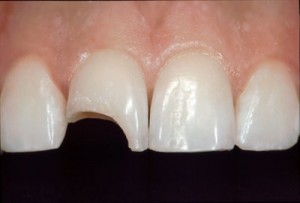
Dental bonding is one of several options available to a dentist to repair cracks or gaps in teeth, as a filling after a cavity has been repaired, or to cover up stains or discolored teeth. While it is a popular method to enhance the aesthetics of your smile, it also has value as a means of protection for the tooth when a patient’s gums have receded to the point of exposing the root.
The choice of when to use bonding as a solution or an alternative process is a decision to make in consulting with your dentist. It is a safe, affordable, and attractive solution for many dental problems. The actual procedure used in bonding will depend on your specific needs. When bonding has been chosen as the best option, the only real preparation required is to roughen the surface of your teeth to enable the bonding material to create the strongest bond possible. Basically, a composite resin is used on the affected tooth or teeth. It is molded and sculpted over an adhesive gel that is placed on the tooth.
After the resin has been applied, a blue LED light is used to harden the resin, which is then polished to give you a fresh, new smile. Once these initial steps are completed, the dentist will spend some time carefully trimming and shaping the result to give your teeth their best possible look. The time needed to complete the procedure for each tooth is between 30 and 60 minutes. In cases where bonding is used to fill a cavity, the patient may need to be anesthetized. Bonding is a definite improvement over the older silver amalgam fillings. With the recent advancements in dental technology, bonding can be expected to a substantial amount of time.
The question for the patient is why should you choose bonding as an alternative solution to other cosmetic and dental procedures? For many patients, the simple answer is price. Bonding is one of the cheapest ways to achieve a long lasting solution to repairing or changing the appearance of your teeth. Another is the amount of time needed to get the desired result. Unless there are a number of teeth that require repair, dental bonding will be a one day process, and you will go home seeing the change in your appearance.
While bonding has a number of definite advantages for the patient, it is not the perfect solution for every patient. One reason is that bonding does not have the same stain resistant characteristics as other procedures such as crowns and veneers. Another problem is the bonding material does not last as long as the alternatives. Though Bonding is a robust solution designed to last many years, crowns have usually a longer life expectancy.
Finally, while the possibility of the bonding material to chip or crack is small, should it occur you will need to have the procedure repeated on the damaged areas. After the procedure is completed, knowing how to maintain your teeth after bonding is essential. Bonding does not replace the need to take care of your teeth through regular dental hygiene such as brushing and flossing. Because the bonding material has a chance of chipping or cracking, if you have nail biting habits you will have to give then up in favor of maintaining your new smile.
You will also have to pay attention to your chewing practices, because should a sharp edge form or your teeth just don’t quite feel right when biting down, you will need to call us and schedule an appointment. Contact us for more information and an initial complimentary consultation with one of our dentists. You can call us at 631-874-4707 or contact using the contact form on our website to set up an appointment that is most convenient for you.


